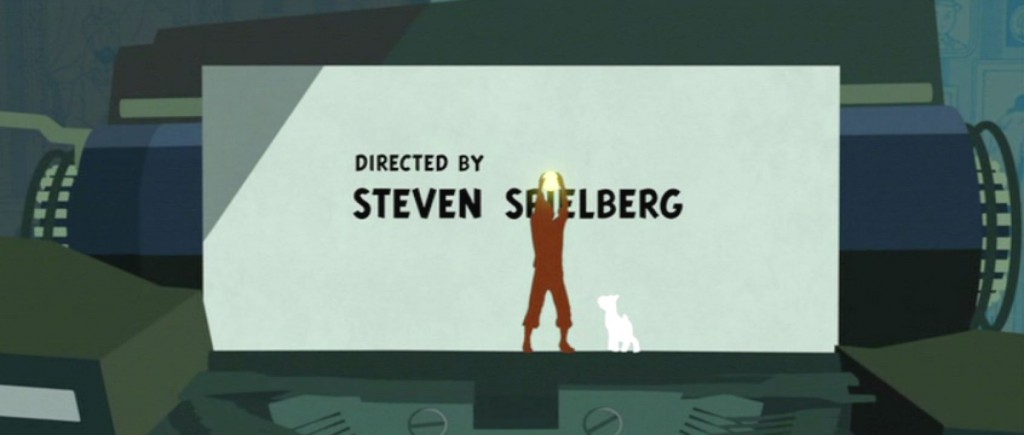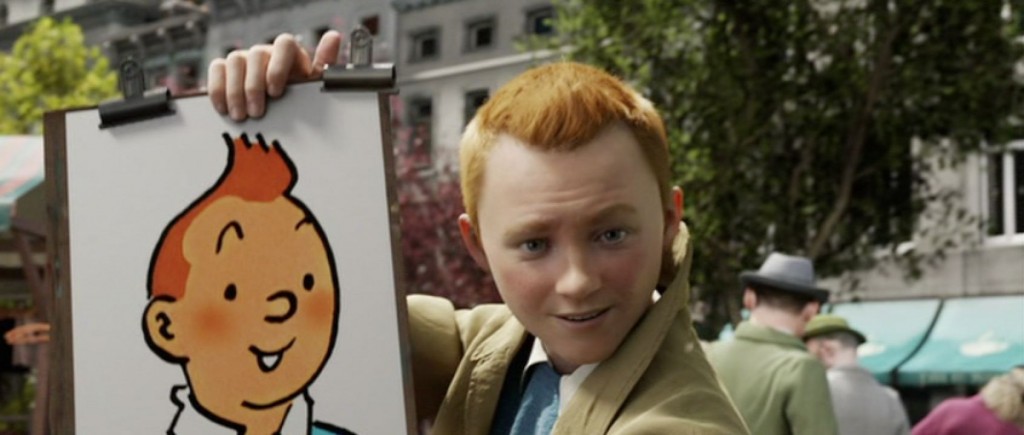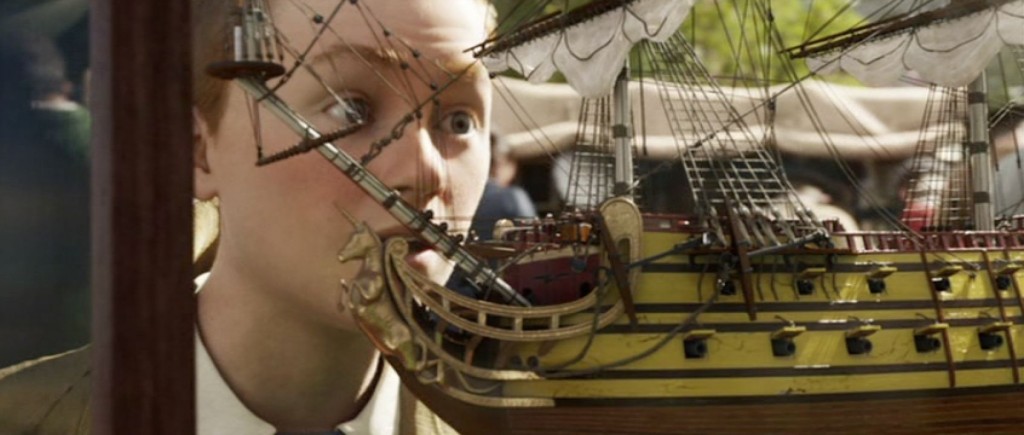Spielberg: The Adventures of Tintin part 1
The opening titles of The Adventures of Tintin, while not technically part of the screenplay, offer a jaunty, tongue-in-cheek symposium on the action-adventure genre. Or, that is to say, on the films of Steven Spielberg. There’s a boy, he’s got a companion, in this case a dog, and there is danger and bad guys and all manner of vehicular transport, often in competition with each other, and a magical object, in this case a glowing ball, that everyone is after. This describes the plots of any number of Spielberg movies. If you wanted, you could expand the titles of Tintin into its own feature, and in fact just describing them would constitute a terrific pitch in most rooms in Hollywood. What is the glowing ball? The glowing ball is, of course, the maguffin, the thing around which the action revolves. For Spielberg, that might be the Ark of the Covenant, the Holy Grail, Devil’s Tower, Private Ryan or an enamelware factory. The point of the maguffin is that it doesn’t matter what it is, it only matters that it’s important to everyone in the story. It could literally be a glowing ball and it would still have the same effect, if exploited properly. At the end of the Tintin titles, it turns out that the glowing ball is the dot to the “i” in “Spielberg,” which adds the personal touch and brings home the fact that the sequence is, in large part, autobiographical — the chase for the maguffin, whatever it is, is the guiding principle of Spielberg’s life, the glow in his eye, or the light of his “I.” That the drama of the titles plays out on a typewriter instead of, say, a drawing board, or an editing table, brings that glowing “I” to the writer’s desk, that is, to the screenplay, where a movie always begins, where it must begin. It’s often been said that Spielberg makes movies about movies, here he acknowledges that openly.
The Adventures of Tintin is also, of course, an adaptation of a series of beloved comic books, and Spielberg takes care to acknowledge that as well, before he gets on with the adventure. He has his Tintin pose for a caricaturist at a street fair, the caricaturist of course being Herge, Tintin’s creator. In this, Spielberg creates a kind of de facto hand off from Herge’s creation to his own, implying that he has (the late) cartoonist’s blessing on the project. Herge was dead for a decade before Spielberg even got the rights to make a Tintin movie, but the “handoff” moment still nods to the comics’ readers, says: it’s okay, we love this stuff too, trust us. (Part of Herge’s winning style was to take cartoonish-looking principals and put them in lush, well-researched, impeccably observed backgrounds, and Spielberg replicates that technique here in CGI — rubber-faced people in photo-realistic environments.)
What does Tintin want? Well, he’s a young man, living on his own, somewhere in Europe, some time in the 1930s, he wants adventure. Note that, in spite of living on his own and being old enough to drive, Tintin isn’t looking for love or sex, just the romance of adventure. I’m guessing Tintin shares that quality with Spielberg himself, who has always been skittish about love matters in his movies — Tintin, throughout his history, is permanently arrested in a pre-sexual adolescence –the perfect Spielberg protagonist. Maybe that’s why one of the first shots of Tintin is him passing by a row of mirrors — Tintin is Spielberg’s reflection of himself.
While a pickpocket deftly moves through the crowd in the square at Montmartre and a pair of bumbling detectives pursue same, Tintin finds adventure, or the symbol of it anyway, in a ship’s model, The Unicorn, for sale by an antiques dealer. Tintin, like the young Spielberg, like young geeks everywhere throughout time, knows more about the ship than the dealer himself, the rigging, the guns, the year built, the king in power at the time. It is in the nature of the young man, not yet preoccupied with girls, to memorize all kinds of useless minutiae regarding vehicles, weapons and history — if he were born forty years later, Tintin would be playing Dungeons and Dragons.
Tintin buys the model ship and is immediately accosted by an older man who also wants it, all but announcing The Unicorn‘s status as a maguffin. Moments later, Tintin is approached a second time, by the bearded Sakharine, who is obviously sinister but who shares with Tintin a geek’s love of minutiae. There is a house, you see, a manor, and a sea captain, and a fortune lost — the stuff, in short, of adventure. Sakharine shows that the geek’s adoration of minutiae, when frozen too long, becomes obsession, as the enthusiast becomes the collector. Tintin is intrigued by Sakharine but unmoved: The Unicorn, and the adventure it symbolizes, is his.



As someone who has fond memories of reading Tintin adventures as a child in serial form in Children’s Digest back in the 60’s, I was prepared to hate this film, and passed on it during its theatrical run.
However, my curiosity got the better of me, I rented it from Netflix, and wound up really enjoying it. I’ll never be a big fan of this animation style, but the story was entertaining and clever enough to enable me to get used to it.
Looking forward to reading the analysis!
For a minute I was confused, because the credits you were describing, which familiar, did not match the ones I remembered. I did a little research and recalled that before the film came out, a fan created some animated opening credits that I remembered more vividly than the ones in the actual film:
http://www.youtube.com/watch?v=5QTWduH7-Oc
The fan-based images pay homage to the titles of each of Herge’s Tintin adventures, in order
http://en.wikipedia.org/wiki/The_Adventures_of_Tintin#List_of_titles
Your confusion is warranted, because I believe the fans who did the original credits I think got hired to do the real credits for the movie.
The nicest thing I can say about the visual style of this movie is that I mostly stopped noticing it after a while. The trouble with uncanny valley imagery is that you notice it for all the wrong reasons, all the ways in which it still doesn’t look real. I eventually got past finding the imagery disconcerting, though character with more stylized designs were tougher to ignore. I still think it’s a bad fit for the material given the simple, clear line style Herge is known for. I recall reading a rationale for going with motion capture on the film – possibly from Spielberg – that basically stated “this way we can cast the best actors for the parts and not worry if they look like the characters.” There another way to do that. It’s called animation.
All that aside, I was pleasantly surprised by how much I did enjoy the movie as someone who has read a lot of Tintin over the years. My friend, who is a much more passionate Tintin fan than me, was also quite happy with the film, so it must have done something right.
I absolutely loved the long, flowing action sequences in this film. You could almost taste the freeing bliss Spielberg must have felt in having a camera he could place and swing whichever way he wanted. After we left the theater my wife told me she had looked over at me during one of those scenes, and I was on the edge of my seat with a shit-eating grin on my face.
Definitely, seeing Spielberg be able to operate without worrying about camera placement or practical effects is worth the price of admission.
A week before I saw Tintin, I had seen Mission Impossible: Ghost Protocol, and I thought “Ghost Protocol is the best action film of 2011.” Then I saw Tintin and had to completely revise my opinion.
I had never read much of the original Tintin comics, but I was put off by the visual look of this film when I first saw the trailers. But, not being a die hard fan, I didn’t have too much interest in it anyway and didn’t see it in the theater. When I noticed it on Netflix, I figured I’d put it on in the background while I, of course, worked on some of my own comics.
I really liked it. I got caught up it in by the time he meets Haddock and thought it was a really fun adventure. I had to watch it again, to take it all in. As I said, I’ve only read a small amount of Herge’s works, so I can’t speak for how faithful this movie is in terms of character, story, or spirit, but it was a thoroughly entertaining Spielberg film. It was VERY Spielbergian, to the point where it makes a better Indiana Jones film than half the Indiana Jones films.
I am curious to see what Peter Jackson does with the next film, if indeed they’re still following through on that.
One thing I did find an odd choice: the opening animated credits, while very awesome and reminiscent of Catch Me If You Can, seemed like they’d be a lot for a kid in the film’s target demographic to sit through. A child who’s not familiar with the source material won’t recognize the silhouettes, and so there’s not much to get them invested in it. While they were very cool, I think it would’ve made more sense to have them as the end credits, so the movie could’ve gotten started quicker.
I was never a reader of the Tintin books growing up. I had a vague sense of who the character was, but not much else. My girlfriend, on the other hand, loved the comics as a child and had worn out copies from rereading them so much. We both loved this film. The art style didn’t bother me–it seemed to find the sweet spot between cartoon and photorealism that didn’t fall into the uncanny valley. I’m not sure why it worked for me, but it did. And this film is by far the best use of 3D I’ve seen to date.